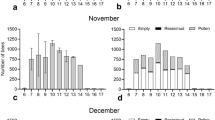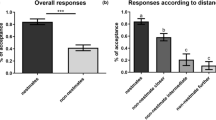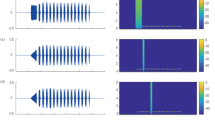Abstract
By using chemical analyses, as well as laboratory and field behavioral tests, we tested the hypothesis that rove beetles of the myrmecophilous genus Pella use alarm pheromone compounds to avert attacks by their host ant Lasius fuliginosus. The secretions of Pella funestus and P. humeralis contain quinones and different aliphatic compounds, mainly undecane and 6-methyl-5-hepten-2-one (sulcatone). The latter two chemicals are also found in L. fuliginosus pheromone glands. Behavioral tests confirmed that undecane serves as an “aggressive alarm”-inducing pheromone in L. fuliginosus, whereas sulcatone most likely is a “panic-alarm”-inducing pheromone. The main tergal-secretion compounds, various quinones and undecane, individually and in mixtures induced aggression in L. fuliginosus workers. When sulcatone was added to these compounds, the space around the odor source was avoided and a reduced number of aggressive acts observed, suggesting that sulcatone blocks the aggression-inducing effect of undecane and the quinones. These results support the hypothesis that Pella beetles mimic alarm pheromones of their hosts. This is a rare example of chemical mimicry in myrmecophilous insects in which chemicals other than cuticular hydrocarbons are used.






Similar content being viewed by others
References
Akino, T. 2002. Chemical camouflage by myrmecophilus beetles Zyras comes (Coleoptera: Staphylinidae) and Diaritiger fossulatus (Coleoptera: Pselaphidae) to be integrated into the nest of Lasius fuliginosus (Hymenoptera: Formicidae). Chemoecology 12:83–89.
Akino, T., Mochizuki, R., Morimoti, M., and Yamaoka, R. 1996. Chemical camouflage of myrmecophilous cricket Myrmecophilus sp. to be integrated with several ant species. Jpn. J. Appl. Entomol. 40:39–46.
Arthur, C. L. and Pawliszyn, J. 1990. Solid phase microextraction with thermal desorption using fused silica optical fibers. Anal. Chem. 62:2145–2148.
Bernardi, R., Cardani, C., Ghiringhelli, D., Selva, A., Baggini, A., and Pavan, M. 1967. On the components of secretion of mandibular glands of the ant Lasius (Dendrolasius) fuliginosus. Tetrahedron Lett. 40:3893–3896.
Bhatkar, A. P. and Whitcomb, W. H. 1970. Artificial diet for rearing various species of ants. Fla. Entomol. 54:229–232.
Dettner, K. and Liepert, C. 1994. Chemical mimicry and camouflage. Annu. Rev. Entomol. 39:129–154.
Duffield, R. M., Brand, J. M., and Blum, M. S. 1977. 6-Methyl-5-hepten-2-one in Formica species: identification and function as an alarmpheromone. Ann. Entomol. Soc. Am. 70:309–310.
Dumpert, K. 1972. Alarmstoffrezeptoren auf der Antenne von Lasius fuliginosus (Latr.) (Hymenoptera, Formicidae). Z. Vgl. Physiol. 76:403–425.
Elgar, M. A. and Allan, R. A. 2004. Predatory spider mimics aquire colony-specific cuticular hydrocarbons from their ant model prey. Naturwissenschaften 91:143–147.
Freude, H., Harde, K. H., and Lohse, G. A. 1974. Die Käfer Mitteleuropas: Band 5. Goecke und Evers Verlag, Krefeld.
Hölldobler, B. and Wilson, E. O. 1990. The Ants. Harvard University Press, Cambridge, Massachusetts.
Hölldobler, B., Möglich, M., and Maschwitz, U. 1981. Myrmecophilic relationship of Pella (Coleoptera: Staphylinidae) to Lasius fuliginosus (Hymenoptera: Formicidae). Psyche 88:347–374.
Howard, R. W. and Blomquist, G. J. 2005. Ecological, behavioral and biochemical aspects of insect hydrocarbons. Annu. Rev. Entomol. 50:371–393.
Kistner, D. H. 1971. Studies of Japanese myrmecophiles, Part I. The Genera Pella and Falagria (Coleoptera; Staphylinidae) in Entomological Essays to Commemorate the Retirement of Professor K. Yasumatsu, pp. 141–165. Hokurynkan Publ. Co. Ltd., Tokyo.
Kistner, D. H. and Blum, M. S. 1971. Alarm pheromone of Lasius (Dendrolasius) spathebus (Hymenoptera: Formicidae) and its possible mimicry by two species of Pella (Coleoptera: Staphylinidae). Ann. Entomol. Soc. Am. 64:589–594.
Lenoir, A., D’Ettore, P., and Errard, C. 2001. Chemical ecology and social parasitism in ants. Annu. Rev. Entomol. 46:573–599.
Maruyama, M. 2006. Revision of the Palearctic species of the myrmecophilous genus Pella (Coleoptera, Staphylinidae, Aleocharinae). National Science Museum Monographs:32.
Maschwitz, U. 1964. Gefahrenalarmstoffe und Gefahrenalarmierung bei sozialen Hymenopteren. Z. Vgl. Physiol. 47:596–655.
Maschwitz, U. and Hölldobler, B. 1970. Der Kartonnestbau bei Lasius fuliginosus. Z. Vgl. Physiol. 66:176–189.
Regnier, F. E. and Wilson, E. O. 1971. Chemical communication and "propaganda" in slave-maker ants. Science 172:267–269.
Schminke, G. 1978. Einfluss von Temperatur und Photoperiode auf Entwicklung und Diapause einiger Staphylinidae. Pedobiologia 18:1–21.
Seifert, B. 1996. Ameisen: beobachten, bestimmen. Naturbuchverlag, Augsburg.
Steidle, J. L. M. and Dettner, K. 1993. Chemistry and morphology of the tergal gland of free-living adult aleocharinae (Coleoptera: Staphylinidae) and its phylogenetic significance. Syst. Entomol. 18:149–168.
Vane-Wright, R. I. 1976. A unified classification of mimetic resemblances. Biol. J. Linn. Soc. 8:25–56.
Wasmann, E. 1886. Über die Lebensweise einiger Ameisengäste I. Deut. Entomol. Z. 30:49–66.
Wilson, E. O. and Regnier, F. E. 1971. The evolution of the alarm-defense system in the formicine ants. Am. Nat. 105:279–289.
Acknowledgments
We thank Cornelia Gantert for continuous support in the establishment and maintenance of the ant colonies used in this study. Andrea Fuhrmann, Angela Hücklhoven, and Stine Mencl contributed by performing behavioral experiments. The manuscript was improved, thanks to comments of anonymous reviewers and the revision by Dr. Astrid Groot and Simone Kienle.
Author information
Authors and Affiliations
Corresponding author
Rights and permissions
About this article
Cite this article
Stoeffler, M., Maier, T.S., Tolasch, T. et al. Foreign-language Skills in Rove-Beetles? Evidence for Chemical Mimicry of Ant Alarm Pheromones in Myrmecophilous Pella Beetles (Coleoptera: Staphylinidae). J Chem Ecol 33, 1382–1392 (2007). https://doi.org/10.1007/s10886-007-9315-0
Received:
Revised:
Accepted:
Published:
Issue Date:
DOI: https://doi.org/10.1007/s10886-007-9315-0




